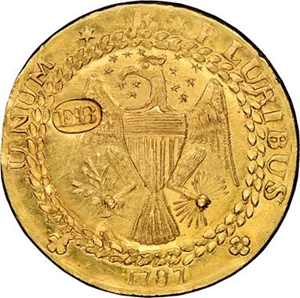Greysheet & CPG® PRICE GUIDE
- U.S. Coins /
- Colonial & Post-Colonial Issues /
-
Brasher Doubloons (1742, 1787) Values
About This Series
Pieces known as Lima Style doubloons were dated 1742, but it is almost certain that they were produced in 1786, and were the first efforts of Brasher to make a circulating coin for local use. Neither of the two known specimens shows the full legends; but weight, gold content, and punchmark are all identical to those for the other Brasher coins. An analogous cast imitation Lima style doubloon dated 1735 bears a hallmark attributed to Standish Barry of Baltimore, Maryland, circa 1787.
An original design was used on the 1787 Brasher doubloon with an eagle on one side and the arms of New York on the other. In addition to his impressed hallmark, Brasher's name appears in small letters on each of his coins. The unique 1787 gold half doubloon is struck from doubloon dies on an undersized planchet that weighs half as much as the larger coins.
It is uncertain why Brasher produced these pieces. He was later commissioned to test and verify other gold coins then in circulation. His hallmark EB was punched on each coin as evidence of his testing and its value. In some cases the foreign coins have been weight-adjusted by clipping.
Catalog Detail
Legal Disclaimer
The prices listed in our database are intended to be used as an indication only. Users are strongly encouraged to seek multiple sources of pricing before making a final determination of value. CDN Publishing is not responsible for typographical or database-related errors. Your use of this site indicates full acceptance of these terms.




















| Brasher Doubloons (1742, 1787) | Value Range | Favorite | |||
|---|---|---|---|---|---|
| Brasher Doubloons (1742, 1787) | Value Range | ||||
|
$2,520,000
-
$2,520,000
$2,520,000 - $2,520,000
|
||||
|
$7,320,000
-
$7,320,000
$7,320,000 - $7,320,000
|
||||
|
$3,000,000
-
$11,220,000
$3,000,000 - $11,220,000
|
||||
|
-
|
||||
|
-
|
||||
From the Greysheet Marketplace
Auction Ends: 12/29/2025
Buy Now: $1,248.75
Buy Now: $425.00
Auction Ends: 12/29/2025
Auction Ends: 12/29/2025
Auction Ends: 12/29/2025
Auction Ends: 12/29/2025
Buy Now: $1,063.75
Buy Now: $370.00
Buy Now: $1,480.00
Related Stories (powered by Greysheet News)
View all news
Greysheet Catalog Details
Pieces known as Lima Style doubloons were dated 1742, but it is almost certain that they were produced in 1786, and were the first efforts of Brasher to make a circulating coin for local use. Neither of the two known specimens shows the full legends; but weight, gold content, and punchmark are all identical to those for the other Brasher coins. An analogous cast imitation Lima style doubloon dated 1735 bears a hallmark attributed to Standish Barry of Baltimore, Maryland, circa 1787.
An original design was used on the 1787 Brasher doubloon with an eagle on one side and the arms of New York on the other. In addition to his impressed hallmark, Brasher's name appears in small letters on each of his coins. The unique 1787 gold half doubloon is struck from doubloon dies on an undersized planchet that weighs half as much as the larger coins.
It is uncertain why Brasher produced these pieces. He was later commissioned to test and verify other gold coins then in circulation. His hallmark EB was punched on each coin as evidence of his testing and its value. In some cases the foreign coins have been weight-adjusted by clipping.
Catalog Detail
Legal Disclaimer
The prices listed in our database are intended to be used as an indication only. Users are strongly encouraged to seek multiple sources of pricing before making a final determination of value. CDN Publishing is not responsible for typographical or database-related errors. Your use of this site indicates full acceptance of these terms.










 Loading more ...
Loading more ...











